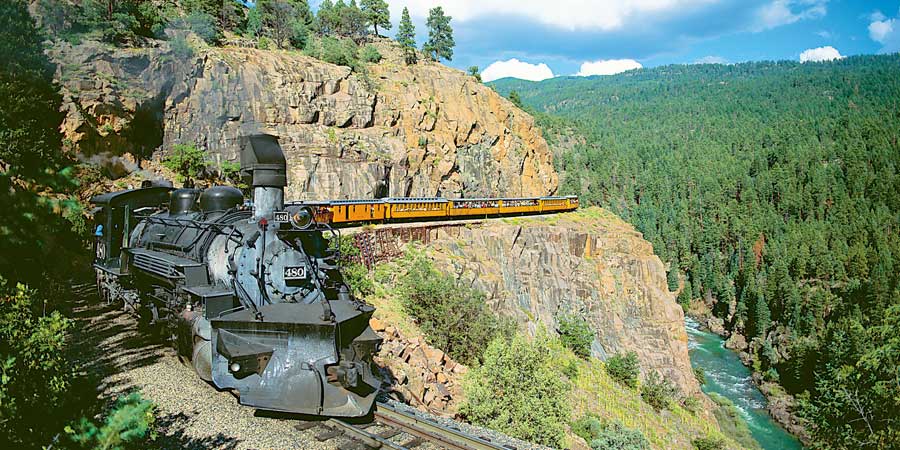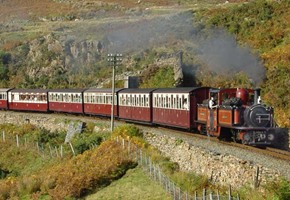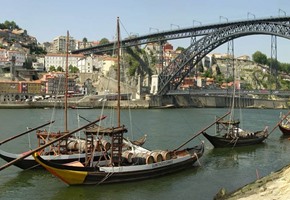Great Rail Journeys Tour Manager Ian Holmes introduces us to the Durango & Silverton Railway in Colorado, one of the world's most celebrated narrow gauge steam routes.
Durango was founded by the Denver & Rio Grande Railway in 1879 and the railroad arrived there on 5 August 1881. Construction on a line to Silverton began towards the end of the same year and by July of 1882 (amazingly, only 9 months after construction began) the 3'-0" gauge tracks to Silverton were completed with trains then hauling both freight and passengers.
It is early July and our journey starts at Silverton after a beautifully scenic coach ride from Grand Junction over the San Juan Mountains. Arriving in Silverton is like entering a Wild West movie set. There are wooden "pavements" either side of dirt streets and signs proclaiming such establishments as "Bent Elbow Hotel", "High Noon Hamburgers" and "Shady Lady Saloon". There is even a stagecoach for those who want an old-time ride around the town.
Closely nestled in a mountain bowl, Silverton is surrounded by high peaks that are frequently draped in snow all year around and we can still see remains of the harsh winter. We arrive in time for lunch while our train arrives along the middle of the street. No station, no platform, there it is: a living steaming former D&RGW K-36 Baldwin 2-8-2 locomotive with its train of bright yellow coaches standing in readiness for its passengers. Plenty of opportunities for those authentic wild-west pictures before we board the train for our journey down the Animas River valley to Durango.
Today the river is in full flow due to ice-melt and some recent heavy rain in the San Juan all of which promises to add to the splendour of this railroad journey which, from the very beginning was promoted as a scenic route for passenger service even though the line was constructed primarily to haul gold and silver mine ores from the San Juan Mountains. It is estimated that over $300 million in precious metals has been transported over this route. By 1885 the population of Silverton had grown to 1,100 but in 1893, ten large mines in the Silverton district were forced to close when silver prices dropped from $1.05/oz to 63¢/oz.
Throughout the next twenty years the railroad faced many challenges: slides, floods, snow, war and financial instability. With the advent of World War 2, the US Government requisitioned narrow gauge equipment to use in Alaska and the smelter in Durango reopened to process uranium for use in the war. As a result of the continuing Cold War, the smelter continued to process uranium instead of silver into the late 1940s. By 1947 the line was in danger of being abandoned but a determined staff stepped in and helped keep it alive by promoting tourism. Then Hollywood discovered Durango and the railroad. Over the next ten years several movies were filmed in the area showcasing the train: Ticket to Tomahawk, Across the Wide Missouri, Denver & Rio Grande, Viva Zapata and Around the World in 80 Days.
During the latter part of the 1960s the Durango-Silverton Narrow Gauge Railroad was registered as a National Historic Landmark but in 1969 the Denver and Rio Grande Western abandoned the tracks south of Durango isolating the line and leaving the future of the line in question once again. Hollywood continued its fascination with the area and the railroad with the filming of Butch Cassidy and the Sundance Kid. Just as the railroad prepared to celebrate its 100th birthday, a certain Charles E. Bradshaw Jr. purchased the line and with the restoration process complete, engine No.481 returned to service after 20 years in retirement.
Throughout the 1980s, the D&SNGRR continued to build on the scenic tourist railroad industry. Major track reconstruction occurred, locomotives No.497 and No.480 were restored and returned to service and now a year-round train service operates with rolling stock indigenous to the line. The locomotives used to pull the trains are all 1923-25 vintage, remain 100% coal-fired, steam-operated and maintained in original condition.
Departing Silverton we pass the old rail depot which has a small museum and the "Y" track formation used to turn the trains around. For the next 45 miles, the beauty around every curve is breathtaking. The train twists and curves along mountain ridges and cliffs, and the tracks cross the river on picturesque (but safe!) trestles. We are on the lookout also along the route for some of the natural inhabitants of the area: bear, elk, deer, foxes, coyotes, falcons, hawks and even bald eagles. A few cougars also live in the high country, but they are unlikely to be spotted from the train.
After 3½ hours of beautiful scenery, we arrive in Durango, at an elevation of 6,512 feet - about 3,000 feet lower than Silverton. Located in southwestern Colorado, and just 36 miles west of the Mesa Verde National Park, the old downtown area of Durango is fascinating; many of the original buildings constructed by Durango's pioneers are still standing today such as the Strater Hotel, and some of the Victorian bars where you might easily expect to see Butch Cassidy or Elzy Lay hanging out, with narrowed eyes and six shooters at their sides!
Discover our tours travelling on the Durango & Silverton Railroad route.



